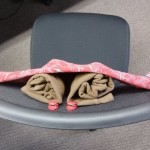
I sit in a cubical for 8 hours a day in front of a computer, and my right shoulder blade goes tingly. When the issue first started, it seemed to come and go for no reason, but working with a physical therapist made it clear that my posture was the issue, and certain things I did made it flare up. Mostly, it’s a long road toward increasing my body’s strength and flexibility, but some external changes have made a big difference, namely reconfiguring my desk. I did all this without waiting around for my employer to by me a $1000 standing desk, and the only thing I spent money on was two napkins, which cost a lot less than the visits to the physical therapist. So I thought I’d share these tips.
Goals
As you can see in the picture above, my elbow was elevated, which the physical therapist said was part of the problem, so I needed to remove the obstacles keeping me from putting my elbows at my sides.
Diagnosis: my scalenes and pectoralis minor were shortened and tight, whereas my levator scapulae and upper trapezius were over-lengthened. To counter this, my shoulders needed to relax down and back, and my head needed to sit further back on my neck and not crane forward.
Changes
Raise the chair
Since I’m short, I had originally lowered my desk chair as much as possible, so my feet wouldn’t swing like a child’s. This was a mistake, since the desk (which is immovable) is positioned for someone sitting higher up. Resting my elbow on the desk probably led to the tightening of my scalenes and pec minor since they were in a shortened position all day. So I raised the chair as high as possible to get to the right height for the desk.
Add a footrest

The new chair position meant I needed to add a footrest. I tried a couple cardboard boxes from around the office until I found one of the right height. To be cute, I bought a pair of cloth napkins at the thrift store and, with some skillfully applied binder clips, used one napkin to cover the cardboard box.
Remove the armrests
The armrests of the chair couldn’t go down very low, and my objective was to relax my shoulders as far as possible, even to get a little stretch. So I unscrewed the armrests from the bottom of the chair and stowed everything under my desk so it can be put back together for a future occupant.
Get the computer within reach
I moved my monitors out of the corner, so they are closer to me and so my keyboard is right at the edge of the desk. In addition, I increased the font size of every possible setting, not because I’m old or have vision problems, but because I was leaning in to read. The last step with the computer was to get rid of the mousepad, so I wasn’t extending my arm to grab the mouse. With no mousepad, I’m more likely to just pull the mouse right to the edge of the desk, which keeps my elbows by my side.
Add a chair-back pad



My office chair has a very curvy seat back, so it looks ergonomic. However, as you can see, it curves in on both sides, which pushes the shoulders forward instead of letting them relax back. I wanted the chair to support my spine, and get out of the way of my shoulders. I made a pad out of a rolled up shirt (the one I kept at my desk anyway for the summer thermostat wars) and held it in place with cubical clips that pin on to the chair back. I covered it with the second cloth napkin for maximum cuteness.
Result
Now when I sit in the chair, my back is supported, my feet are supported, I’m not craning my neck forward, and my elbows hang at my sides, all of which lets my shoulder blades stay in a tingle-free spot on my back. This reduced the tingling by about 50%, which is awesome. Unfortunately, it also made it clear that I needed a chair with “seat depth” adjustment (my thigh bones or femurs are shorter than the seat, so my back can’t reach the back rest) so I put in an order for a new chair …but I picked one with a convex back rest and no arm rests.
The biggest lesson of physical therapy has been that there is no silver bullet. At first I tried to cheat, and just remove the armrests, or just do the one exercise that seemed the most important to me. I got no results that way. However, if the physical therapist gave me 7 things to do, and I picked 5 of them, I’d be on track…but the crazy part was, it didn’t matter which 5. There just needs to be a suite of improvements in place, doesn’t matter which ones. This is sort of annoying and sort of a relief, as medical advice and life lessons go.
Learning about human anatomy has been the best part of having a medical problem! I found useful diagrams here: http://www.studyblue.com/notes/note/n/anatomy-muscles/deck/6174851